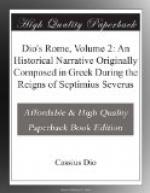It happened like this.
[B.C. 52 (a.u. 702)]
The Parthians confronted the Romans with most of their army hidden; the ground was uneven in spots and wooded. Crassus seeing them—not Crassus the commander, but the younger, who had come to his father from Gaul,—and despising them (supposing them to be alone), led out his cavalry and, as they turned purposely to flight, pursued them. In his eagerness for victory he was separated far from his phalanx, and was then caught in a trap and cut down. [-22-] When this took place the roman infantry did not turn back, but valiantly joined battle with the Parthians to avenge his death. They accomplished nothing worthy of themselves, however, because of the enemy’s numbers and tactics, especially as they suffered from the plotting of Abgarus. If they decided to lock shields for the purpose of avoiding the arrows by the density of their array, the pike-bearers were upon them with a rush, would strike down some, and at least scatter the others: and if they stood apart, so as to turn these aside, they would be shot with arrows.
Hereupon many died from fright at the very charge or the pike-bearers, and many hemmed in by the horsemen perished. Others were upset by the pikes or were carried off transfixed. The missiles falling thick upon them from all sides at once struck down many by an opportune blow, put many out of the battle, and caused annoyance to all. They flew into their eyes and pierced their hands and all the other parts of the body and penetrating their armor, forced them to take off their protection and expose themselves to wounds each minute. Thus, while a man was guarding against arrows or pulling out one that had stuck fast he received more wounds, one upon another. Consequently it was not feasible for them to move, nor feasible to remain at rest. Neither course afforded them safety, and both were fraught with destruction, the one because it was out of their power, and the other because they were more easily wounded. [-23-] This was what they suffered while they were fighting only against visible enemies. Abgarus did not immediately make his attempt upon them. When he, too, attacked, the Orshoeni themselves struck the Romans from behind in exposed places while they were facing in a different direction, and rendered them easier for the others to slaughter. For the Romans, altering their formation, so as to be facing them, put the Parthians behind them. They wheeled around again against the Parthians, then back again against the Orshoeni, then against the Parthians once more. Thrown into still greater confusion by this circumstance, because they were continually changing position this way and that and were forced to face the body that was wounding them at the time, many fell upon their own swords or were killed by their comrades. Finally they were shut up in so narrow a place, with the enemy continually assaulting them from all sides at once, and compelled to protect their




